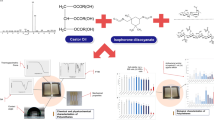Abstract
Biodegradable polymers have a variety of uses in basic and clinical research, as well as important therapeutic applications. The most commonly used are poly (lactic acid), poly (glycolic acid) and their copolymer, poly (L-lactic-co-glycolic acid) or PLGA. The incorporation of a plasticizer into a polymer can be used to obtain a product with specific properties. In this work, we examined the influence of a plasticizer (triethylcitrate) on the properties of PLGA membrane implants for human clinical uses. Membranes with and without plasticizer were dense and compact and contained no pores. The incorporation of 7% plasticizer enhanced the degradation the polymer when compared to polymer without plasticizer. In membranes without plasticizer, the initiation of degradation was very slow and was seen only 60 days after implantation, should allow the use of this material in the repair of damage tissue. In both cases, macroscopic analysis showed that there was no adhesion of the membrane to capsule fibrous, and this adversely affected preservation of the polymer. With time, the adherence of the polymer to surrounding tissue increased. Overall there was little degradation of membranes without plasticizer compared to those containing plasticizer.
Similar content being viewed by others
References
M. D. DAVIS and J. P. VACANTI Biomaterials 17 (1996) 365.
R. M. LUCIANO, C. A. C. ZAVAGLIA, E. A. R. DUEK and M. C. ALBERTO-RINCON, “Synthesis and characterization of poly (L-lactic acid) membranes: studies in vivo and in vitro.” Journal of Materials Science: Materials in Medicine 14 (2003) 87.
A. VAN SLIEDREGT, J. A. VAN LOON, J. VAN DER BRINK, K. DE GROOT and C. A. VAN BLITTESWIJK Ibid. 15 (1994) 251.
L. LU and A. G. MIKOS, The importance of new processing techniques in tissue engineering. Mater RES Soc Bull 21 (1996) 28.
L. LU, S. J. PETER, M. D. D. LYMAN, H. L. LAI, S. M. LEITE, J. A. TAMADA, S. UYAMA, J. P. VACANTI, R. LANGER and A. G. MIKOS, “In vitro and in vivo degradation of porous poly (DL-lactic-co-glycolic acid) foams.” Biomaterials 21 (2000) 1837.
J. E. BABENSEE, J. M. ANDERSON, L. V. MCINTIRE and A. G. MIKOS, Host response to tissue engineered devices. Adv Drug Deliv Rev 33 (1998) 111.
S. H. BARBANTI, A. R. SANTOS JR, C. A. C. ZAVAGLIA and E. A. R. DUEK Porous and dense poly (L-lactic acid) and poly(D,L-lactic acid-co-glycolic acid) scaffolds: In vitro degradation in culture medium and osteoblasts culture. Journal of Materials Science: Materials in Medicine 15 (2004) 1315.
R. M. LUCIANO, “Synthesis, characterization and degradation of poly (lactic acid) membranes, a bioabsorbable polymer.” UNICAMP, Masters dissertation, 1997.
R. M. LUCIANO, E. A. R. DUEK and M. C. ALBERTO-RINCON, “The effect of triethylcitrate on the porosity and biocompatibility of poly (lactic acid) membranes” Braz. J. morphol. 18 (1) (2001) 7.
H. PISTNER, D. R. BENDIX, J. MUHLING and J. F. REUTHER, “Poly (L-lactide)—a long-term degradation study in vivo. 3 Analytical characterizations.” Biomaterials 14 (1993) 291.
D. R. M. SILVIA, S. M. N. SCAPIN, P. P. JOAZEIRO, M. C. ALBERTO-RINCON, R. M. LUCIANO and E. A. R. DUEK “In vivo interaction of cells on poly L- (lactic acid) membranes containing plasticizer,” Journal of Materials Science: Materials in Medicine 13 (2002) 327.
M. C. C. SPECTOR and TONG-LI, The local tissue response to biomaterials. Crit. Rev. Biocomp. 5 (1989) 269.
A. TEZCANER, K. BUGRA and V. HASIRCI Retinal pigment epithelium cell culture on surface modified poly (hydroxybutyrate—co—hydroxyvalerate) thin films. Biomaterials. 24 (2003) 4573.
J. E. BERGSMA, F. R. ROZEMA, R. R. M. BOS, G. BOERING, W. C. de BRUIJIN and A. J. PENNINGS, Biocompatibility study of as-polymerized poly (L-lactide) in rats using a cage implant system. Journal of Biom. Mat. Res. 29 (1995) 173.
G. J. BEUMER, C. A. VAN BLITTRESWIJK and M. PONEC, Biocompatibility of a biodegradable matrix used as a skin substitute: An in vivo evaluation. Journal of Biom. Mat. Res. 28 (1994) 545.
K. H. LAM, J. M. SCHAKENRAAD, H. ESSELBRUGGE, J. FEIJEN and P. NIEUWENHUIS, The effect of phagocytosis of poly (L-lactic acid) fragment on cellular morphology and viability. Journal of Biomedical Materials Research: Materials in Medicine 27 (1993) 1569.
Author information
Authors and Affiliations
Rights and permissions
About this article
Cite this article
Pietro, L., Silva, D.R.M., Alberto-Rincon, M.C. et al. The influence of triethylcitrate on the biological properties of poly (L-lactic-co-glycolic acid) membranes. J Mater Sci: Mater Med 17, 849–857 (2006). https://doi.org/10.1007/s10856-006-9845-y
Received:
Accepted:
Issue Date:
DOI: https://doi.org/10.1007/s10856-006-9845-y




